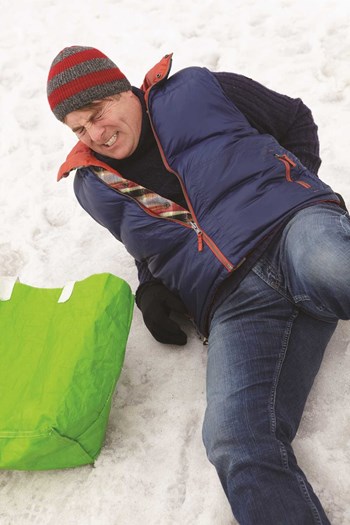
A billboard brags about a car with “all-wheel-drive for the winter months and a sunroof for the summer ones,” and New Englanders smile knowingly. Nevertheless, the fact is that Northeastern winters can be serious business, and for few more so than for property owners and homeowner associations.
Snow and ice are, it turns out, a multifaceted challenge. For example, the snow in 2010 was relentless, and as the snowflakes fell, concerns rose about where to put the snow; about ice dams; and, in Massachusetts, about what, exactly, an association’s responsibility is when it comes to removing snow and ice in a timely fashion.
Great Expectations
For Massachusetts associations and other property owners, 2010 was not just a snowy year, but also one that brought changes to laws about snow and ice removal requirements. Previously, Massachusetts law contained wording about the "unnatural accumulation of snow and ice" which developed in case law over time. According to this wording, if, for example a large pile of snow or sudden sheet of solid ice formed that seemed to be out of the norm, the property owner would have to take action: Shovel, sand, use salt. Otherwise, if the accumulation was the natural result of the snowfall, it was not the owner’s immediate responsibility.
But then, in 2010 a man named Emanuel Papadopoulos slipped and fell on the ice in a Target department store parking lot and sued the company. Ultimately the court decided that distinction between "natural" and "unnatural" accumulation was false, and threw out that long-standing wording.
"Now,” says Attorney Frank Flynn, managing partner at the law firm of Downing & Flynn in Boston, “people need to know that if there is snow and ice, the property owner owes a duty to everybody—all lawful visitors—to use reasonable care to make the property reasonably safe.”
The law is the same across the board for every owner of property—including a homeowner or condominium association. The association owns the common areas, and this law applies even to the sole-use parking spaces of residents. Flynn says, “No longer can you wait around for unnatural accumulation before clearing. Legally, associations now have to act every time there’s snow and ice.”
Since the Papadopoulos case, people are more aware of these legal standards, and, Flynn admits, there has been a spike in “slip-and-fall” cases. Brendon Kilcoyne, sales executive at H&K Insurance Agency, Inc., concurs, adding that insurance companies have seen increased financial awards in slip-and-fall lawsuits in community associations.
“Lost earnings, pain and suffering would be part of the damages that an injured person could get,” Flynn warns, and recommends that all associations have their snow removal crews come out any time there is any snow and ice at all, because one never knows what could happen. “Comas cost millions,” he says.
It was the Supreme Judicial Court in Massachusetts that set the standard following the Papadopoulos case, and more information about the Papadopoulos case can be obtained through an attorney’s office. However, most cities and towns across New England also have their own ordinances requiring snow removal at properties, with each town’s ordinances being somewhat different. For specifics regarding municipal guidelines, property owners should inquire at town offices. Associations would also be wise to draw up their own guidelines in writing.
The 411 to Avoid 911
Local requirements aside, the basic assumption throughout New England now is that it is the association’s responsibility to keep all areas “reasonably safe.” Associations therefore must have a game plan in place long before the snow-clearing need arises. It is not enough simply to shovel walkways or plow driveways. Consideration must also be taken regarding where to put the piles of shoveled snow, and also regarding accumulation on roofs. Ice dams can cause expensive property damage, and a sheet of ice or snow sliding off a roof can once again obstruct a walkway, or even fall on a person, thus increasing risk of injury and claims. “Homeowner associations have to clear all walkways,” says Michael Pasquino, senior portfolio manager at Barkan Management Co. in Boston, “even city sidewalks that run by their property—clear out fire hydrants and such.”
Property management companies like Barkan are responsible for contracting out seasonal upkeep work to landscaping and maintenance contractors, generally bidding the jobs out each year or so. Pasquino says there are two different ways an association can choose to contract out for snow removal—the all-inclusive contract (for all snow, regardless of amount) or the a la carte approach, which depends on the amount of snow. The amount of snow that triggers plow arrival varies with any given contract agreement. In the case of an a la carte agreement, contractors will often charge by number of inches, and will also charge extra when special equipment such as Bobcats are required.
Mark Lindblom, owner of Lindblom Landscaping and Home Repair in Auburn, Massachusetts,, is unaware of associations or management companies that do not pay a flat seasonal fee for snow and ice removal and recommends this option. He admits the flat fee works to the contractors’ advantage during dry winters, but any other payment plan could financially bury an association if the winter is extra snowy, as many of the last few have been.
Contractors like Lindblom cite a variety of ways they keep property “reasonably safe,” as the Massachusetts law has it, for businesses and condominiums. The most basic snow-cleaning tool, after the shovel and plow, is, of course, ice melt. The cheapest and oldest variety, commonly known as “rock salt” is calcium chlorate, which is effective at melting ice, but unfortunately it also essentially “melts” concrete, getting into the pores of pavement, heating up and splitting it apart. When utilizing calcium chlorate, frequent restorative maintenance during other seasons should be assumed. Lindblom asserts that contractors must use calcium chloride, a similar application but both significantly more expensive and less damaging a product than its chlorate counterpart.
Within the last two years a liquid version of the calcium chloride mixture has been developed for use on city streets. It is green in color and works better than rock salt, without the damaging salt and sand that get mixed in with that. Lindblom says contractors can buy it in bulk and share it out to other contractors so that it is an option for treatment at condominiums, too.
Other, more initially expensive, options for snow removal are heated sidewalks and driveways, and the permeable paver system. Both of these systems are expensive to install and Lindblom observes that heated sidewalks, which rely on radiant electric heat to melt snow and ice, have an ongoing expense of electricity to run them. He and Pasquino, however, agree that they work well. Pasquino contends that heated surfaces are “effective in specific locations for a specific problem,” though Lindblom says he has seen communities with sidewalks successfully heated throughout.
The permeable paver system is not a method for snow maintenance in an entire community but could be a solution in problem areas, especially where there is a likely accumulation of water from melting snow which may then refreeze. This system works by excavating a dry well that is deeper than the geothermal frost line, in the area to be paved. The well is filled with layers of stones decreasing in size as they reach the surface, and then paving slabs are laid on top. This system creates good drainage for the wet area and utilizes the constant 54 degree (F) temperature of the earth below the frostline to help keep ice from forming.
Regardless of new paving and ice melting technologies, however, the likelihood of a crew needing to come out and shovel or plow or snow-blow at least some portion of a property is high. Unless the property also contains its own snow field, contractors will need to remove the piles of plowed and shoveled snow off the property, too, to prevent them from melting into walks and driveways and refreezing, as happened in the Papadopoulos case. Constant clearing is so necessary that Lindblom says contractors must have special insurance, and sometimes crews will stay on a site over 24 hours—for example, during a blizzard—simply to make sure entryways, exits, walkways and driveways are cleared at least hourly.
A Word About Insurance
Naturally, contractors are not the only party in the snow-removal process to require insurance. Management companies can be as or more liable in some slip-and-fall cases as homeowner associations, and they must be insured for such occasions. Likewise, associations must be sure their insurance policies are up-to-date and able to grant them the highest protection. “There is no specific winter coverage; however, I do recommend high limits of liability that would generally cover slips and falls from ice, snow falling on vehicles, property, and people,” says Kilcoyne. Insurance companies, he notes, have been encouraging condominium associations to make changes to their snow removal policies. The major changes, he notes, include stronger and more concrete contract language covering just how and when the snow will be removed in the event of a storm. At the same time, he insists that residents should be directed to avoid removing snow themselves “at all costs.”
Attorney Flynn also reminds associations that it is the management and condominium associations who are responsible to take care of common areas, and of snow removal specifically. He cites a case where a unit owner was leasing his unit and the lessee injured herself in front of the property. She sued the unit owner, but in the end, the fault was found to be the association’s because she slipped in a common area. As people become more aware of slip-and-fall policies and laws, and as they become more and more willing to resort to litigation in the case of an unfortunate event, it is imperative that associations do their homework before the winter begins. Fortunately, there are ample resources and products available to ensure that winter at New England condominiums passes by without a hitch. Or a slip.
Jennifer Grosser is a Massachusetts freelance writer and a frequent contributor to New England Condominium.






4 Comments
Leave a Comment